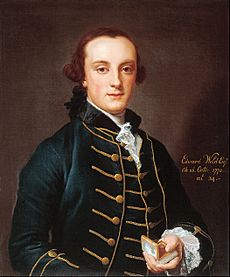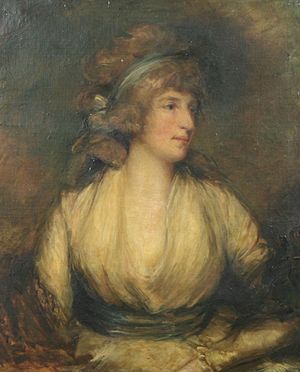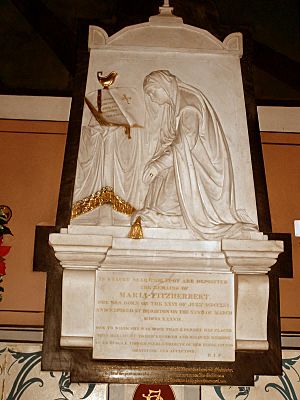Maria Fitzherbert facts for kids
Quick facts for kids
Maria Fitzherbert
|
|
|---|---|
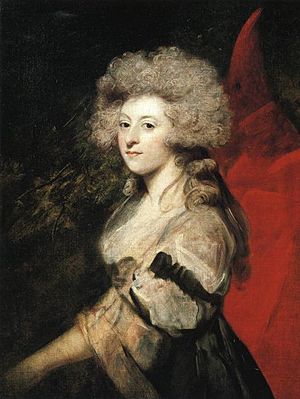
Portrait by Sir Joshua Reynolds, 1788
|
|
| Born |
Maria Anne Smythe
26 July 1756 Tong Castle, England
|
| Died | 27 March 1837 (aged 80) Steine House, Brighton, England
|
| Resting place | St John the Baptist's Church, Kemptown, Brighton |
| Spouse(s) | |
| Children | at least 1 (with Thomas Fitzherbert) |
| Parents |
|
Maria Anne Fitzherbert (born Maria Anne Smythe, later Weld; 26 July 1756 – 27 March 1837) was a special friend of George, Prince of Wales. He later became King George IV of the United Kingdom. In 1785, they secretly got married. However, this marriage was not legal under English law. This was because George's father, King George III, did not agree to it.
Maria Fitzherbert was a Catholic. At that time, the law said that a Catholic or someone married to a Catholic could not become the monarch. If their marriage had been legal, Prince George would have lost his place as the next king. Before marrying George, Maria had been a widow twice.
Contents
Early Life and Education
Maria Fitzherbert was born at Tong Castle in Shropshire, England. She was the oldest child of Walter Smythe. Her mother was Mary Ann Errington. Maria went to school in Paris, France, at a convent.
Maria's Marriages
When Maria was eighteen, she married Edward Weld in July 1775. He was 16 years older than her. Edward was a wealthy Catholic widower who owned Lulworth Castle. Sadly, Edward died just three months later after falling from his horse. He had not signed his new will, so his money and property went to his younger brother. This left Maria with very little money. She had to find a new husband soon.
Three years later, in 1778, she married Thomas Fitzherbert. He was ten years older than her. They had a son who died when he was very young. Maria became a widow again on 7 May 1781. Thomas left her some money each year and a house in London.
Her Relationship with Prince George
After being widowed twice, Maria Fitzherbert became part of London's high society. In 1784, she met George, Prince of Wales. He was six years younger than her. The prince fell in love with her and kept asking her to marry him.
On 15 December 1785, they secretly had a marriage ceremony. They both knew it was against the law. The ceremony took place in Maria's house in London. Her uncle and brother were witnesses. A chaplain of the prince performed the ceremony. The prince paid the chaplain's debts so he could be released from prison.
Why the Marriage Was Not Legal
This marriage was not legal under English law. The Royal Marriages Act 1772 said that the King's permission was needed. King George III and his advisors had not approved the marriage. They likely would not have approved for several reasons. One main reason was Maria's Catholic faith.
If the marriage had been legal, Prince George would have lost his right to become king. This was because of laws like the Bill of Rights 1689 and the Act of Settlement 1701. These laws prevented Catholics or those married to Catholics from ruling. His younger brother, the Duke of York, would have become the next in line.
Later Years with George
In 1794, Maria was told that her relationship with the Prince was over. George told his brother that they had "parted amicably." He planned to marry his cousin, Duchess Caroline of Brunswick. King George III said this was the only way to pay off the prince's huge debts. So, the Prince married Caroline on 8 April 1795.
In 1796, after his daughter was born, the Prince wrote his will. He left everything to "my Maria Fitzherbert, my wife, the wife of my heart and soul." He wrote that even though she could not be called his wife publicly, she was his wife "in the eyes of Heaven."
The Prince wanted to get back together with Maria in 1798. By then, he had separated from Caroline.
King George IV and Maria
When George became King George IV, his feelings towards Maria changed. He sometimes spoke of her with "disgust." He claimed their marriage was not real because there was no official license. Maria had documents proving their union. When she needed her yearly payments, she sometimes hinted that she would make her papers public if she didn't get the money.
In June 1830, when the King was dying, he received a "get well soon" letter from Maria. He put it under his pillow. Maria was sad that he never replied. However, before he died, the King asked to be buried with a small painting of Maria's eye around his neck. This was done.
After King George IV died on 26 June 1830, his letters from Maria were found. Steps were taken to destroy them. Maria told George IV's brother, King William IV, about their marriage. She showed him the document she had. King William IV asked her to accept the title of Duchess, but she said no. She only asked for permission to wear black clothes like a widow and for her servants to wear royal uniforms.
Maria's Death and Memorial
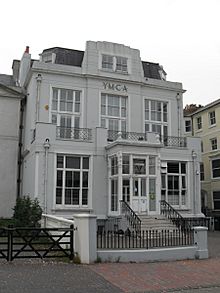
The architect William Porden designed Steine House in Brighton for Maria Fitzherbert. She lived there from 1804 until she died in 1837. She was buried at St John the Baptist's Church, Brighton. Maria had helped pay for much of this church. Her memorial sculpture inside the church shows her wearing three wedding rings.
Appearance
Maria Fitzherbert was described as having a nose that curved slightly. She had hazel eyes, soft blonde hair, and clear skin.
Maria Fitzherbert on Screen
Maria Fitzherbert has been played by several actresses in films and TV shows:
- Nora Swinburne in the 1943 film The Man in Grey
- Joyce Howard in the 1947 film Mrs. Fitzherbert
- Rosemary Harris in the 1954 film Beau Brummell
- Jeanette Sterke in the 1957 BBC Sunday-Night Theatre TV play The Lass of Richmond Hill
- Susannah York in the 1979 television series Prince Regent
- Caroline Harker in the 1994 film The Madness of King George
Images for kids
-
Commemorative plaque at Maria Fitzherbert's burial place in Brighton


